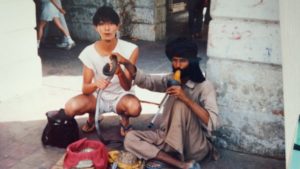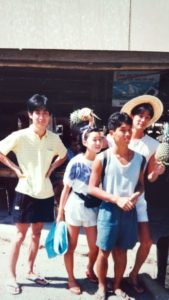Sunday Special: This Japanese honcho’s love for India is unmatched
Before joining JCCII, Kenji Sugino worked with All Nippon Airways (ANA) for 30 years, including 6 years in India from 2007 to 2013. He opened up Mumbai and Delhi offices in India.
NEW DELHI: Kenji Sugino (54), who has come to India as the secretary-general of Japan Chamber of Commerce and Industry in India (JCCII) this time, owns a 31-year old emotional connect with India when he visited this country as a backpacker.
Kenji Sugino’s first visit to India was in 1988 when he was a student.
He wanted to go to the holy city Varanasi to find out “Why people die?”.
Deeply in distress after the death of his younger brother who succumbed to the cancer disease at the age of 12, Sugino closely watched the burning pyres off the banks of sacred river Ganga in Varanasi to explore and know more about how the soul leaves the body and takes a new place in another body.

“When traveling as a backpacker, I realized that it was important to be able to jump into someone’s mind to grab the hearts of the local people. Knowing the local culture, life, and religion is important for communicating from the perspective of the other party. Then you can see how to tell, and the other side can trust and listen to you,” said Sugino.
So how do you learn culture?
Sugino was taught by Indians. Make full use of the five senses (visual, auditory, tactile, gustatory, and olfactory) to share clothing, food, and accommodation. Wear Indian national costume, sandals, eat Indian food, sleep on a wooden bed.
“For example, if you look around the city from the car window and walk around, the world you can understand is completely different. Walking with the same eyes as Indians do, drinking sweet chai (tea) on the roadside. Talking to Indians who are approaching with interest. Then we would be able to understand what is so good that the chai you drink on the roadside is very tasty, and you can’t find a word that is more than “Aachha” with shaking my head to express its taste,” said Sugino.
And also, it was at that time when he realized that India had had tough living conditions, the atmospheric temperature was generally high, sometimes experienced heavy rains, and he saw poor people carrying huge luggage on their backs, yet people were generally looking happy and their eyes shined.
“At that time, I decided that I will come back and work here in India only,” asserted Sugino.
Sugino had joined All Nippon Airways (ANA), Japan’s biggest airline company in 1988 after returning from India.
“I spent a comparatively long time engaging in front-line such as Passenger Services at the Tokyo Airport Office, Administration of Cabin attendant at Narita Airport Office, Passenger sales at Fukuoka Office and Corporate sales at Tokyo office with the intention of bringing Japan closer to all over the world, but finally I wanted to go to India,” said Sugino.
ANA’s Indian route started in 1996 but had to suspend the service between Tokyo and Osaka to Delhi and Mumbai both in 2002 because of declining global aviation demand after the terrorist attack (9/11) on USA’s twin World Trade Towers and Pentagon.

It was in March 2007, however, ANA decided to restart Tokyo-Mumbai flights.
“I proposed the board members to send me to India because I had an experience there and I wanted to work with Indian people. In the same year, I came to India. In October 2007 ANA had restarted airline service from Mumbai to Tokyo,” said Sugino.
“The Tokyo-Mumbai route launched service on September 1, 2007, six months after going to India, but it was a mess for the first two years. I couldn’t get any permissions, no one was hired, and I worked without subordinates. Thanks to the supporters who came from Japan, we managed to do everything. But it went slower than expected. So everyone was exhausted. However, in the end, I managed to do my best,” recalls Sugino.
When he hit the wall, Sugino recalled the words that he once was taught by his seniors.
“There is a way whenever there is a will,” said Sugino adding, “However, in 2008, a terrorist attack 26/11 happened in Mumbai, and ANA decided to reduce the service from 4 to 3 times a week, as against its plans to introduce daily flights between the two countries. As I got used to working with local people in India, I was able to get help from Indian staff, government officials, business partners, customers. Then in 2009, we started a daily flight from Mumbai and also from Delhi in 2012 with Boeing 767 and I shifted from Mumbai to Delhi. Now both flights are daily flight by 787 and the flight from Chennai also had started from Nov 2019. I am really grateful for the help. Without them, I would not have been able to get to know about India, to launch the Delhi-Tokyo route and to get bigger aircraft for the Mumbai-Tokyo route.”
After this, Sugino became a Director of the International Passenger Sales for 3 years and the Marketing and Sales planning for 2 years, both at the Tokyo Headquarter. He resigned in October 2018 from ANA after 30 years of service.
Former Japanese Chamber of Commerce (JCCII) Secretary-General Kazuharu Kono invited him to come to India as a successor. It was founded under Societies Registration Act, 1860, and was established on 17th July 2006. JCCII’s membership is open to, in principle, Japanese companies, and Japanese government institutions in India and over 440 companies are enrolled currently.

“After 7 years, I finally came back to India. Now, I’m 53 years old and belong to JCCII, my aim is – Bringing India closer to Japan through further development of bilateral economic and cultures. I strongly believe this is a great opportunity to make my dream come true. I’m looking forward to working with local people. I want to return the favour to the people and society. This is what Hinduism and Buddhism teach us. In ancient India, it was said that life was divided into four periods: brahmacharya, gārhasthya, vanaprastha, and saṃnyāsa. Vanaprastha is the most brilliant “third life” between 50 to 75 years old. After fulfilling the obligations to society and family in the gārhasthya, one should face his or her own life during the vanaprastha.” said Sugino.
Now as a new secretary-general of JCCII, Sugino wants to increase the membership and contribute to the growth of India-Japan trade. In order to achieve the goal, the development of the Indian economy should be progressed faster with the cooperation of members of JCCII, the Japanese and Indian Governments, CII, FICCI, ASSOCHAM, and other economic organizations, etc. He is also planning to make efforts to strengthen the relationship between Japan and India, as well as to promote Japanese language education and cultural exchange.
Sugino loves India, its art, culture, environment, and people. He loves to wear Indian ethnic attires such as Modi jacket (Nehru cut) too on some occasions and loves to see Bollywood movies as well. Sugino has had his roots in India for more than 30 years and is willing to work for improvement in the Japan-India relationship. We look forward to his further success and expect him to bring benefits to Japan and India.



